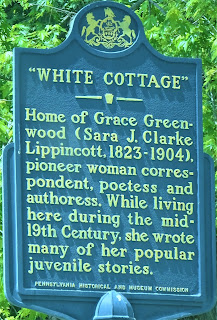We're at the start of a three-day heat wave here in eastern Pennsylvania, and I keep asking my Alexa how I can opt out of it but she doesn't have any helpful information. I hope everyone is keeping cool and safe.
For this week's quest, we're going to head back to Beaver County, where John Robinson has once again shared his beautiful photos of a marker and its subject. I'm going to be completely honest and say that until he sent me the pictures, I had honestly never heard of today's subject - either by her real name or by her pen name. However, I am also an author and most people have never heard of me either, so she and I have that in common. (Her marker calls her an "authoress" and also a "poetess," which I find oddly delightful.)
 |
| The marker stands in front of the house on Third Avenue, New Brighton. Image courtesy of John Robinson. |
Sara's earliest works were poems and stories for children, which she wrote under both her real name and her pseudonym. Occasionally, she would have two pieces in the same publication, one under each name. When she was 21 years old, she had a poem published in the New York Mirror, which gave her some national attention, and this led to her being published in various literary magazines of the time, such as the Home Journal. She became an assistant editor of Godey's Lady's Book and an editor of Godey's Dollar Newspaper. Summers were spent at the family home in New Brighton, known as "White Cottage," while winters were spent variously in Philadelphia, New York City, or Washington D.C., serving as a "lady correspondent" for various publications - including, eventually, the Saturday Evening Post. Perhaps most remarkably, she was the first female correspondent for the New York Times. Her first book, published in 1850, was a collection of many of her early writings and given the title of Greenwood Leaves.
 |
| Sara Lippincott/Grace Greenwood, circa 1850. Public domain image courtesy of Wiki Commons. |
In the mid-1850s, a few things happened to change Sara's life. One was that she made her first trip to Europe, on assignment for the New York Times. She fell in love with the place (I can relate) and was there for a little more than a year, later referring to the time as "the golden year of her life." Her correspondence was published, after her return to the United States, as Haps and Mishaps of a Tour in Europe. Meanwhile, in 1853, she married Leander Lippincott, a colleague from Philadelphia. Together they founded a children's literary magazine, The Little Pilgrim, with Sara as the primary editor and frequent contributor. The Little Pilgrim is particularly memorable today as having been the publication in which Louisa May Alcott made her writing debut.
Sara's marriage was, unfortunately, not a very happy one. The couple welcomed their only child, daughter Annie Grace, in 1855. Leander was a frequent philanderer, however, which made for splendid fodder in the gossip columns, and Sara didn't appreciate that or the fact that her publications were now copyrighted under her husband's name. Leander took a job with the federal government, but was eventually dismissed and indicted for fraud concerning Native American land claims. Rather than face justice, he fled the country, abandoning his wife and daughter. I can't find any record of what happened to him after that, but I get the distinct impression from my reading that Sara didn't miss him much. According to his profile at FindAGrave.com, he eventually returned to the United States; he died in 1896, and is buried in Baltimore, Maryland.
Sara, meanwhile, continued pursuing her passion. During the Civil War she used her writings to raise funds for the U.S. Sanitary Commission, and often gave speeches to troops and patriotic organizations, for which she received personal commendation from President Abraham Lincoln; he dubbed her "Grace Greenwood the Patriot." After her husband's defection, Sara's writing and the fees she received for providing guest lectures kept herself and Annie fed, as she supported Annie's efforts to become a stage actress. They moved to London for a time, where Sara continued corresponding for American publications; she also worked for the London Journal and wrote a biography of Queen Victoria, focusing on her childhood and early rule. Although she did return to Washington, D.C. in the 1890s, she came to the realization that life in Europe was better for her health.
Sara was staying with Annie and her husband, Herbert Winslow, at their home in New Rochelle, New York, when she died of bronchitis on April 20, 1904. She was returned to her beloved New Brighton, and is buried in the Grove Cemetery there. The "White Cottage" of her youth remains a landmark in the community, and today serves as the rectory of the Christ Episcopal Church, which stands next door.
 |
| "White Cottage" (at left) in New Brighton. Image courtesy of John Robinson. |
Sources and Further Reading:
Except where indicated, all writing and photography on this blog is the intellectual property of Laura Klotz. This blog is written with permission of the Pennsylvania Historical and Museum Commission. I am not employed by the PHMC. All rights reserved.

No comments:
Post a Comment
I would love to hear from you!